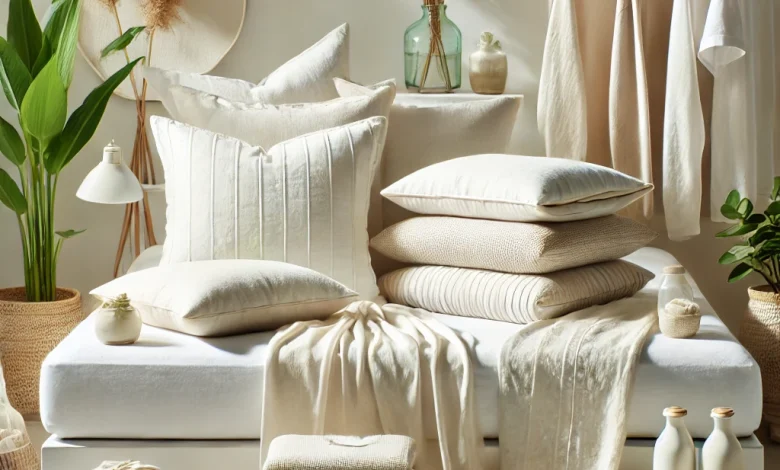Hypoallergenic Textiles: Top 6 Insights for Allergy-Free Living

Table of Contents
Introduction
Explanation of Hypoallergenic Textiles
Hypoallergenic textiles refer to fabrics specifically designed to reduce the likelihood of causing allergic reactions. These materials are crafted to minimize exposure to allergens such as dust mites, mold, pet dander, and certain chemicals commonly found in traditional textiles.
Importance of Hypoallergenic Materials in Everyday Life
With allergies and skin sensitivities on the rise, hypoallergenic textiles offer a practical way to create safer and more comfortable environments. From clothing to bedding, these materials play an essential role in improving quality of life, particularly for individuals with sensitive skin or respiratory conditions.
The Growing Demand for Hypoallergenic Products
The demand for hypoallergenic textiles is surging as consumers become more aware of the harmful effects of allergens and toxic chemicals in conventional fabrics. Increasingly, people are prioritizing health-conscious choices, driving manufacturers to innovate and expand their hypoallergenic product lines.
2. What Are Hypoallergenic Textiles?
Definition of Hypoallergenic Textiles
Hypoallergenic textiles are fabrics designed to reduce or prevent allergic reactions. They achieve this by using natural fibers or treatments that resist common allergens and avoid irritating substances such as synthetic dyes or harsh chemicals.
Materials Commonly Used in Hypoallergenic Fabrics
Several natural and organic materials are popular in hypoallergenic textiles due to their skin-friendly properties:
- Organic Cotton: Free from pesticides and synthetic chemicals, organic cotton is gentle on sensitive skin.
- Bamboo: Naturally antibacterial and moisture-wicking, bamboo is an excellent choice for reducing allergens.
- Silk: Smooth and breathable, silk is resistant to dust mites and ideal for delicate skin.
- Wool: Certain types of wool, like Merino, are hypoallergenic when processed without harsh chemicals.
Characteristics That Make Textiles Hypoallergenic
The key features that distinguish hypoallergenic textiles include:
- Dust-Mite Resistance: Prevents the accumulation of dust mites, a common allergen.
- Chemical-Free Manufacturing: Avoids the use of harmful substances like formaldehyde, synthetic dyes, and fragrances.
- Soft Texture: Gentle fabrics reduce skin irritation and promote comfort.
- Breathability: Allows better airflow to reduce moisture, which can harbor allergens.
3. Benefits of Hypoallergenic Textiles
Reduced Risk of Allergies and Skin Irritation
Hypoallergenic textiles are crafted to minimize exposure to irritants, making them ideal for individuals with eczema, asthma, or other sensitivities. By eliminating common allergens, these fabrics create a healthier environment.
Enhanced Comfort for Sensitive Skin and Respiratory Conditions
The soft, breathable nature of hypoallergenic textiles ensures maximum comfort, especially for those with skin prone to rashes or itchiness. Additionally, these fabrics help improve air quality by reducing airborne allergens, benefiting individuals with respiratory issues.
Environmentally Friendly and Chemical-Free Manufacturing
Many hypoallergenic textiles are made using sustainable and eco-friendly processes. By avoiding harmful chemicals, these fabrics not only protect your health but also contribute to a cleaner environment.
4. Common Applications of Hypoallergenic Textiles
Clothing
Hypoallergenic clothing is a game-changer for people with sensitive skin. Garments made from organic cotton, bamboo, or silk provide comfort without triggering allergic reactions. These fabrics are particularly popular in underwear, activewear, and baby clothes.
Bedding
Hypoallergenic bedding—including sheets, pillowcases, and comforters—ensures a restful night’s sleep. These products are often treated to resist dust mites and mold, creating a healthier sleep environment.
Home Furnishings
Furniture and decor items such as curtains, upholstery, and carpets can trap allergens. Hypoallergenic textiles in these applications help reduce allergen buildup, making homes safer for allergy sufferers.
Baby Products
Infants and toddlers have delicate skin that requires extra care. Hypoallergenic textiles are widely used in baby clothes, blankets, and toys to protect against irritation and allergic reactions.
5. How to Choose Hypoallergenic Textiles
Look for Certified Organic or Hypoallergenic Labels
When shopping for hypoallergenic textiles, prioritize products with certifications such as Global Organic Textile Standard (GOTS) or Oeko-Tex®. These labels ensure that the fabrics meet strict standards for safety and environmental impact.
Consider Natural Fibers Over Synthetic Materials
When selecting hypoallergenic textiles, prioritizing natural fibers over synthetic materials is essential for minimizing skin irritation and allergic reactions. Natural fibers provide several advantages due to their origin, breathability, and compatibility with sensitive skin, making them a preferred choice for those seeking comfort and safety.
Advantages of Natural Fibers:
- Skin Compatibility:
Natural fibers like organic cotton, bamboo, and silk are gentle on the skin and free from the harsh chemicals often present in synthetic materials. This makes them ideal for individuals prone to conditions like eczema, rashes, or psoriasis. - Enhanced Breathability:
Natural fibers allow for better airflow, reducing heat and moisture buildup. This helps prevent the growth of allergens like bacteria, mold, and dust mites, which thrive in damp environments, ensuring greater comfort and safety for users. - Moisture-Wicking Properties:
Many natural fibers, such as bamboo and wool, have moisture-wicking properties that keep the skin dry by absorbing sweat. This reduces skin irritation and minimizes the chance of allergen accumulation. - Sustainability:
Natural fibers are biodegradable and eco-friendly. Unlike synthetic materials, which are often petroleum-based and contribute to environmental pollution, natural fibers come from renewable sources and have a lower environmental footprint. - Chemical-Free Processing:
Organic natural fibers are cultivated without harmful pesticides and processed without the use of synthetic dyes, formaldehyde, or flame retardants, ensuring their hypoallergenic integrity.
Common Natural Fibers Used in Hypoallergenic Textiles
- Organic Cotton:
- Why It’s Hypoallergenic: Free from pesticides and synthetic fertilizers, organic cotton is one of the most widely used hypoallergenic fibers. Its softness and breathability make it suitable for clothing, bedding, and baby products.
- Applications: T-shirts, bed linens, baby clothes, and towels.
- Bamboo:
- Why It’s Hypoallergenic: Naturally antibacterial, bamboo fibers resist the growth of mold, bacteria, and dust mites, making them perfect for sensitive skin. Bamboo is also highly absorbent, ensuring a dry and comfortable feel.
- Applications: Socks, activewear, bedsheets, and underwear.
- Silk:
- Why It’s Hypoallergenic: Silk’s smooth texture minimizes friction against the skin, making it ideal for delicate or irritated skin. Additionally, silk resists dust mites and other common allergens.
- Applications: Pillowcases, sleepwear, and scarves.
- Wool (Merino and Organic Wool):
- Why It’s Hypoallergenic: Certain types of wool, such as merino wool, are hypoallergenic when processed without harsh chemicals. Wool naturally repels dust mites and regulates temperature.
- Applications: Blankets, sweaters, and socks.
- Linen:
- Why It’s Hypoallergenic: Made from flax plants, linen is breathable, durable, and resistant to moisture buildup, making it ideal for warm climates and hypoallergenic bedding.
- Applications: Curtains, bedding, and clothing.
Why Avoid Synthetic Materials?
- Chemical Residues:
Synthetic fabrics like polyester, nylon, and acrylic are often treated with chemical finishes such as flame retardants, wrinkle-free coatings, or waterproofing agents. These chemicals can leave residues that irritate the skin or exacerbate allergies. - Low Breathability:
Unlike natural fibers, synthetic materials trap heat and moisture, creating a humid environment conducive to allergen growth, such as mold and bacteria. - Environmental Concerns:
Synthetic materials are non-biodegradable and contribute to microplastic pollution in waterways during washing. Their production processes also rely heavily on fossil fuels.
Tips for Selecting Natural Fibers
Research Production Processes:
Choose products from manufacturers that prioritize sustainable and chemical-free processing to ensure the hypoallergenic benefits of the material are preserved.
Check Labels:
Always read fabric composition labels to ensure the product is made from 100% natural fibers or has a high percentage of natural content.
Look for Certifications:
Certifications such as GOTS (Global Organic Textile Standard) or Oeko-Tex Standard 100 ensure the product meets high safety and environmental standards.
Avoid Blended Fabrics:
Blends of natural and synthetic materials may compromise hypoallergenic properties. For example, cotton-polyester blends can retain chemical residues from polyester.
Test for Sensitivities:
Even natural fibers like wool can cause reactions in individuals allergic to lanolin. Always test new materials before extended use.
Benefits of Natural Fibers for Hypoallergenic Textiles:
- Skin-Friendliness:
Natural fibers, such as cotton, bamboo, silk, and wool, are less abrasive and more gentle on the skin, reducing the likelihood of irritation or allergic reactions. These fibers are ideal for individuals with eczema, psoriasis, or other skin sensitivities. - Breathability:
Natural fibers have excellent moisture-wicking properties, allowing air to circulate and preventing excessive heat and moisture buildup. This reduces the growth of bacteria, fungi, and dust mites, common triggers for allergies. - Chemical-Free Production:
Many natural fibers, especially organic variants, are grown without pesticides or synthetic fertilizers and processed without harsh chemicals. This ensures fewer residues on the fabric, enhancing their hypoallergenic properties. - Eco-Friendliness:
Natural fibers are biodegradable and renewable, making them a more sustainable choice compared to synthetic fabrics like polyester, nylon, or acrylic, which can take hundreds of years to decompose.
Common Natural Fibers Used in Hypoallergenic Textiles:
- Organic Cotton:
- Grown without pesticides or chemical fertilizers, organic cotton is one of the most popular hypoallergenic fabrics. It is soft, breathable, and suitable for clothing, bedding, and baby products.
- Bamboo:
- Bamboo fibers are naturally antibacterial and moisture-wicking, making them ideal for sensitive skin. Bamboo textiles are also incredibly soft, lightweight, and environmentally friendly due to bamboo’s rapid growth rate.
- Silk:
- Known for its smooth texture and luxurious feel, silk is hypoallergenic and naturally resistant to dust mites and mold. It is a top choice for pillowcases, bedding, and delicate clothing.
- Wool:
- While some individuals may be sensitive to wool, hypoallergenic variants like merino wool or organic wool are gentle and excellent for temperature regulation. Wool naturally repels dust mites and is resistant to mold growth.
- Linen:
- Derived from flax plants, linen is a breathable, durable, and hypoallergenic fabric that resists moisture buildup, making it ideal for warm climates or bedding.
Why Avoid Synthetic Materials?
Synthetic materials like polyester, nylon, and acrylic are manufactured using petrochemicals and often undergo treatments with flame retardants, dyes, and other chemical finishes that can leave harmful residues. These chemicals can irritate sensitive skin and exacerbate conditions like asthma or eczema. Furthermore, synthetic fibers lack the breathability of natural fabrics, creating a humid environment that encourages bacterial and fungal growth.
Tips for Choosing Natural Fibers:
Consider Allergies: While natural fibers are generally hypoallergenic, some individuals may have specific sensitivities (e.g., lanolin in wool). Always test new fabrics before extended use.
Certifications Matter: Look for certifications like GOTS (Global Organic Textile Standard) or Oeko-Tex to ensure the fabric is genuinely organic and free from harmful substances.
Blend Awareness: Be cautious of fabrics labeled as “natural blends,” as they may contain synthetic materials that compromise hypoallergenic properties.
Check for Chemical-Free Dyes and Finishes
When choosing hypoallergenic textiles, it’s vital to pay attention to the dyes and finishes used in the manufacturing process. Many fabrics on the market are treated with synthetic dyes, flame retardants, formaldehyde, and other chemical finishes to enhance their appearance, durability, or flame resistance. However, these substances can release volatile organic compounds (VOCs) or residues that irritate sensitive skin, trigger allergies, or even lead to respiratory issues.
Key Aspects to Consider:
- Natural or Plant-Based Dyes: Look for textiles colored with natural or plant-based dyes derived from sources like turmeric, indigo, or beetroot. These dyes are chemical-free and less likely to irritate the skin.
- Oeko-Tex Certified Products: The Oeko-Tex Standard 100 certification ensures that the textile has been tested for harmful chemicals and is safe for human use, making it an excellent choice for hypoallergenic textiles.
- Chemical-Free Finishes: Avoid fabrics treated with wrinkle-resistant, stain-resistant, or waterproofing chemicals, as these often rely on toxic substances like formaldehyde or perfluorinated compounds (PFCs). Instead, opt for untreated or naturally finished fabrics.
- Bleach-Free Processing: Some textiles, especially organic cotton, go through bleaching processes that leave residues of chlorine or other harsh chemicals. Choosing unbleached fabrics ensures a purer and more hypoallergenic material.
- Allergen-Free Flame Retardants: For items requiring flame resistance, such as children’s clothing or bedding, seek products that use natural alternatives like wool instead of synthetic flame-retardant chemicals.
Why It Matters
The chemicals used in conventional dyes and finishes can compromise the hypoallergenic properties of textiles, negating their intended benefits. For individuals with eczema, asthma, or chemical sensitivities, exposure to these substances can exacerbate symptoms. Furthermore, opting for chemical-free textiles supports a more sustainable and environmentally friendly production process, reducing the environmental impact of harmful chemicals.
By prioritizing chemical-free dyes and finishes, you ensure that your textiles remain safe, comfortable, and truly hypoallergenic. This attention to detail not only protects your health but also aligns with a commitment to sustainability and eco-conscious living.
Look for Anti-Microbial and Dust-Mite-Resistant Properties
Many hypoallergenic textiles come with added features like anti-microbial treatments or tightly woven structures that prevent dust mites and other allergens from accumulating.
6. Caring for Hypoallergenic Textiles
Washing Tips to Maintain Hypoallergenic Properties
Proper care is essential to preserve the hypoallergenic nature of your textiles. Use cold or warm water and gentle cycles to avoid damaging the fibers. Always follow the care instructions provided by the manufacturer.
Avoid Harsh Detergents
Proper care of hypoallergenic textiles extends to the type of laundry products you use. Traditional detergents often contain harsh chemicals, artificial fragrances, optical brighteners, and enzymes that can leave residues on the fabric, potentially triggering skin irritation and allergies. Using a gentle, hypoallergenic detergent is crucial for maintaining the integrity of the fabric while ensuring it remains safe for individuals with sensitive skin.
Key Considerations for Choosing Laundry Detergents:
- Fragrance-Free Options: Artificial fragrances are common irritants. Opt for unscented detergents to eliminate potential allergens.
- Chemical-Free Formulas: Look for detergents labeled as free from phosphates, sulfates, chlorine, and optical brighteners, which can linger on fabrics and cause irritation.
- Plant-Based Detergents: Choose plant-based or biodegradable detergents, which are gentler on both the fabric and the environment.
- Testing New Products: Before using a new detergent on all your laundry, test it on a small batch of textiles to ensure no adverse reactions occur.
- Fabric-Specific Cleaners: For delicate hypoallergenic fabrics like silk or wool, use specialized detergents that cater to their unique care needs.
Washing Tips:
- Use cold or lukewarm water, as hot water can weaken certain natural fibers and may degrade hypoallergenic properties over time.
- Avoid fabric softeners, as they often contain fragrances and chemicals that could counteract the hypoallergenic qualities of the textiles.
- Consider adding a second rinse cycle to ensure all detergent residues are thoroughly removed.
Proper Storage
Storing hypoallergenic textiles correctly is equally important in maintaining their allergen-free qualities. Improper storage can lead to the accumulation of dust, mold, and mildew, which can trigger allergies or degrade the fabric’s properties.
Best Practices for Storing Hypoallergenic Textiles:
- Clean Before Storing: Always wash and dry textiles thoroughly before storage to remove dust, oils, and allergens. Storing dirty fabrics can attract pests or promote mold growth.
- Use Breathable Storage Bags: Avoid plastic storage bags that trap moisture and encourage mold. Instead, choose breathable cotton or linen bags that allow air circulation while protecting the fabric from dust.
- Avoid Damp or Humid Spaces: Store textiles in cool, dry areas away from direct sunlight to prevent fading and moisture buildup. Consider using dehumidifiers or silica gel packets in storage spaces to maintain dryness.
- Dust-Free Environment: Store textiles in drawers or closets that are regularly cleaned and free from dust. Adding cedar blocks or lavender sachets can also help deter pests naturally.
- Rotate Usage: For bedding and clothing, rotate items periodically to prevent long-term compression or creases that could weaken the fabric.
Special Considerations for Sensitive Textiles:
When storing for an extended period, wrap items in acid-free tissue paper to protect them from discoloration.
For delicate hypoallergenic fabrics like silk or bamboo, fold items carefully to avoid stretching or distortion.
Conclusion
Hypoallergenic textiles provide a safe and effective solution for individuals seeking comfort and protection from allergens and irritants. Whether in clothing, bedding, or home furnishings, these materials help reduce exposure to common allergens like dust mites, mold, and chemical residues. By choosing natural fibers such as organic cotton, bamboo, and silk, and ensuring they are free from harmful dyes and finishes, you can create a healthier environment for yourself and your loved ones.
Furthermore, the growing demand for hypoallergenic products highlights the importance of making informed, health-conscious decisions when purchasing textiles. Proper care and maintenance, including using mild detergents and storing fabrics in clean, dry spaces, ensure these materials retain their beneficial properties over time. Embracing hypoallergenic textiles not only promotes better health but also aligns with eco-friendly practices, making them a choice that benefits both people and the planet.
FAQs
1. What does hypoallergenic mean in textiles?
Hypoallergenic textiles are fabrics designed to minimize the risk of allergic reactions. They are typically made from natural or organic fibers and avoid the use of harsh chemicals, synthetic dyes, and allergen-attracting properties like dust mite buildup.
2. Are hypoallergenic textiles suitable for people with sensitive skin?
Yes, hypoallergenic textiles are ideal for individuals with sensitive skin. Their chemical-free and soft textures reduce the chances of irritation, making them a popular choice for people with conditions like eczema or psoriasis.
3. What certifications should I look for when buying hypoallergenic textiles?
Look for certifications like Global Organic Textile Standard (GOTS), Oeko-Tex Standard 100, or similar eco-friendly labels. These certifications ensure the textiles are free from harmful chemicals and safe for use.
4. Can hypoallergenic textiles prevent allergies entirely?
While hypoallergenic textiles can significantly reduce exposure to allergens, they cannot guarantee complete prevention of allergies. Other environmental factors, like cleanliness and air quality, also play a role in minimizing allergic reactions.
5. What are the best natural fibers for hypoallergenic textiles?
Organic cotton, bamboo, silk, merino wool, and linen are among the best natural fibers for hypoallergenic textiles due to their gentle, breathable, and chemical-free properties.
6. How can I tell if a fabric is truly hypoallergenic?
Check for labels and certifications indicating the fabric is organic or hypoallergenic. Additionally, ensure it is free from synthetic dyes, chemical treatments, and allergen-attracting properties.
7. Do hypoallergenic textiles require special care?
Yes, they require gentle care to maintain their properties. Use mild, hypoallergenic detergents, avoid fabric softeners, and store them in breathable, clean spaces to prevent dust and mold buildup.
8. Are synthetic fabrics always bad for allergies?
Not necessarily. Some synthetic fabrics are treated to be hypoallergenic, but they often lack the breathability and eco-friendly qualities of natural fibers. Always check for certifications and chemical-free finishes.
9. Can I find hypoallergenic options for children and babies?
Yes, hypoallergenic textiles are widely available for baby clothes, bedding, and toys. These products are designed to protect delicate skin and reduce irritation or allergic reactions in infants.
10. Are hypoallergenic textiles more expensive?
Hypoallergenic textiles, especially those made from organic materials, can be more expensive due to their sustainable production and higher-quality standards. However, their long-term health benefits and durability often justify the cost.
You May Also Read



